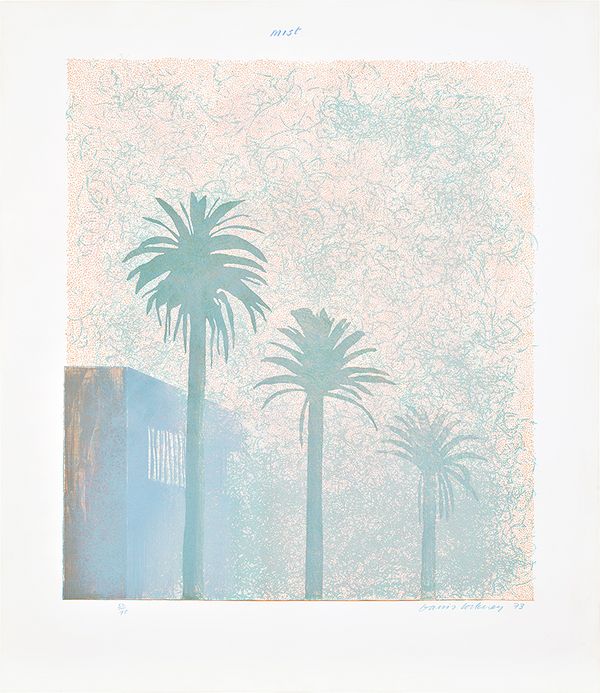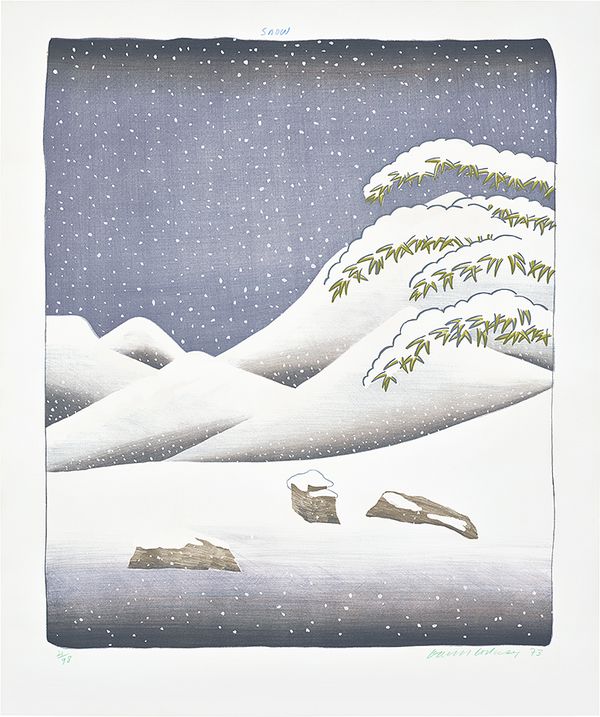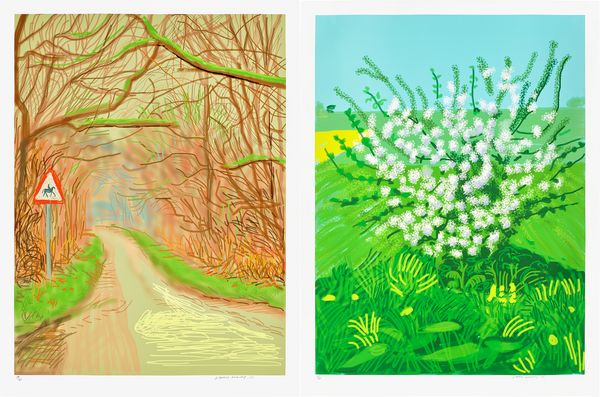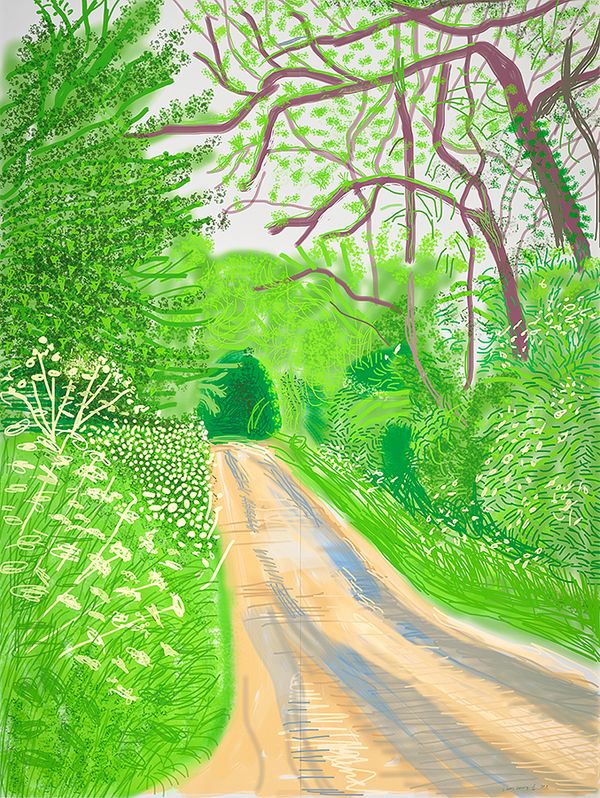David Hockney, The Arrival of Spring in Woldgate, East Yorkshire in 2011 (twenty eleven) — 16 May, 2011. David Hockney.
Summer fades in September; some leaves cling to green while others give in to yellow and orange. The breeze shakes every tree without preference, and the temperatures blow hot and cold at whim. We argue about the weather because the weather argues with itself, but, as David Hockney memorably remarked, “There’s no such thing as bad weather.” The seasons and their ever-changing nature have long enchanted Hockney. He is part of a lineage of artists, from Bruegel to Turner, Monet to Van Gogh, who have dedicated themselves to translating nature’s moods through light and color. But for Hockney, as much as the seasons themselves are of interest, it is the process of understanding how to depict their shifts that truly drives his fascination. To do this, he looks — really looks — no matter what the weather.
Hockney derives deep pleasure from observation. His fascination with nature’s perpetual flux and its sense of transience — of things changing moment by moment — is at the core of his engagement with the seasons. “When you are working outside, you realize that it’s changing all the time,” Hockney said, echoing the frustrations of Claude Monet, who exclaimed while at work that “everything changes, even stone.” Monet’s sustained focus on the shifting light of day across the seasons, the way that even seemingly solid forms are altered by weather and time, resonates deeply with Hockney’s own experience. This understanding that the world is never static and that inspiration resides in this movement and change is what makes the seasons such a boundless subject matter for him.
There is no such thing as bad weather.
—David Hockney
Hockney’s first sustained exploration of weather as a subject came with his Weather Series of 1973, created at the Gemini G.E.L. printmaking workshop in Los Angeles. The series includes works titled Mist, Snow, Sun, Rain, Lightning, and Wind and marks Hockney’s fascination with the challenge of rendering intangible atmospheric conditions — what he called “the weather drawn.” Sidney Felsen, co-founder of Gemini, remarked that Hockney was inspired to make the series because “Los Angeles had no weather.” Perhaps missing the temperamental conditions of his native Yorkshire, Hockney took on the challenge of depicting weather, exploring how to convey the elusive qualities of light, fog, rain, and wind through graphic means.

David Hockney, Mist, from Weather Series, 1973. David Hockney.
In Mist, Hockney conjures the soft, enveloping haze of an unusually foggy day in Los Angeles. The city’s iconic palm trees, typically seen against bright blue skies, appear as faint silhouettes amidst the dense, dreamlike mist. When creating the lithograph, he was adamant to not simply spray the page with ink — “You know, it’s too easy,” he remarked. Instead, Hockney conjured the mist with sponged and stippled pink hues over the receding blue palm trees, creating a suggestion of spatial recession before they disappear into the encroaching obscurity. Far from static, the mist seems to shimmer and move, suggesting that if we wait any longer, we too will be engulfed in the foggy Californian haze. In addition, through his subtle, refined use of overlaid pink and blue, Hockney reminds us that what may first seem to be a grey autumn day is in fact full color if we really look.
If it's rainy I'll draw the rain, if it's sunny I'll draw the sun… The world is very, very beautiful if you look at it, but most people don't look very much.
—David Hockney
Hockney’s interest in weather and atmospheric conditions was heavily influenced by the representation of nature in Japanese art, particularly Katsushika Hokusai’s Thirty-six Views of Mount Fuji (c. 1830 to 1832), which depicts the iconic mountain in all seasons and types of weather. Hockney made various journeys to Japan between 1971 and 1973 and, although initially disappointed by the industrial scenery, quickly became enamored by Japanese traditional art that depicted rolling hills, vast mountainous topography, and bucolic country idylls. The stylized compositions, bold colors, and carefully outlined forms of Japanese woodblock prints significantly influenced Hockney’s own approach to landscape. In Mist, we can see echoes of these Japanese prints in the simplified, graphic forms and the delicate rendering of the atmospheric effects, as Hockney skillfully balances detail with suggestion.

David Hockney, Snow, from Weather Series, 1973. David Hockney.
The influence of Japanese seasonal landscapes is even more apparent in Snow, another work from the Weather Series. In this serene winter scene, snow falls gently across the page, creating a pristine white blanket that covers the rolling hills. Dappled dots of snow illuminate the night sky, accumulating in cloud-like puffs on tree branches. Horizontal bands of tonal gradation amidst swathes of un-inked page create rolling, marshmallow-topped peaks that recede into the background to create illusions of depth in the otherwise two-dimensional scene. Recalling the snow-laden prints of Japan’s Edo period, Snow is rendered with stylized naturalism and deceptive simplicity. We see this gracefully mirrored in Hockney’s own meditation on the subject, at once detailed and restrained, sparse and balanced. Both Hockney and Hokusai’s work interweaves the grandeur of nature with highly refined form and color to create entrancing compositions that follow close observation of the natural landscape. In Snow, Hockney’s delicate portrayal conveys the quiet majesty of a peaceful midwinter where the only movement is the silent accumulation of powdery bliss.
I was looking forward to it. I couldn't wait to get up there. And in a way, I think I had more pleasure looking at the winter, and spring coming, than anything I’ve done.
—David Hockney
If winter is a time of quiet contemplation in Hockney’s work, then spring is a season of energy and transformation. His seminal series, The Arrival of Spring in Woldgate, East Yorkshire in 2011 (twenty eleven), is an epic of nature that documents both the subtlety and drama of winter’s transformation into spring. The series was conceived in anticipation of the artist’s landmark 2012 retrospective, A Bigger Picture, at the Royal Academy in London. In preparation, the artist returned to his late-mother’s Bridlington home in 2006, so that he could experience and record five Yorkshire springs. Commencing on New Year’s Day, 2011, and culminating in early June, the Arrival of Spring sequence chronicles how winter’s icy roads, violet mists, and frosted branches gradually blossom into the luscious greens and clear skies of late spring.

David Hockney, The Arrival of Spring in Woldgate, East Yorkshire in 2011 (twenty eleven) — 14 March, 2011. Right: David Hockney, The Arrival of Spring in Woldgate, East Yorkshire in 2011 (twenty eleven) — 30 April, 2011. David Hockney.
In the Arrival of Spring series, Hockney followed the lead of Vincent van Gogh, who found that spring’s arrival in Arles in 1888 spurred him into “a fury of work.” As he described in a letter to his brother Theo, "The trees are in blossom and I would like to do a Provençal orchard of tremendous gaiety." Between March and late April, the artist dedicated fourteen canvases to the subject — a small foray compared to Hockney’s sixty-one iPad drawings — in which van Gogh depicted the enchanting spring light and budding foliage. That Hockney could harness the digital medium to an equally striking effect as the Dutch master did with paint is a testament to his innovative artistic approach and observational prowess, inserting him into the canonical lineage of great artists who have paid homage to the transient nature of passing seasons.
I myself almost don’t know which season I like best; I believe all of them, equally well.
—Vincent van Gogh
In the work dated 14 March, Hockney's warm palette of burnt ochre, softened with hints of luminescent green, beautifully captures a fleeting early spring moment. The pale blue tonal shifts at the path's end create a sense of depth, while the arching branches form a cozy, enveloping cocoon, inviting the viewer to embark on the same journey through the Yorkshire countryside. By 30 April, the scene has transformed — the browns of bare trees have given way to vibrant greens, fields of yellow rapeseed that stretch beneath a bold blue sky, and the brilliant white hawthorn blossom. This period at the height of spring, which Hockney calls "Action Week," is marked by his urgency to capture the fleeting blooms before they fade. With the arrival of 16 May, the final moment before summer unfolds, Hockney presents a richly textured and immersive scene, bursting with rich green foliage. The flickering light between the leaves hints at the intensity of the coming summer sun, capturing the fullness and abundance of late spring in all its glory.

David Hockney, The Arrival of Spring in Woldgate, East Yorkshire in 2011 (twenty eleven) — 16 May, 2011. David Hockney.
Using unorthodox and novel mediums to communicate his vision from the onset of his career, The Arrival of Spring series demonstrates Hockney’s perpetual enthusiasm for approaching new technologies of image-making. The newly-released iPad granted Hockney a distinct sense of immediacy — he worked quickly and intensely, building up layers with a highly saturated palette and a wide variety of paint effects. Despite the digital nature of the medium, the final, physical artwork remained at the forefront of Hockney’s mind. As he created the series, he simultaneously experimented with printing the drawings directly from the iPad in different variations. Once the scale of the printed images was settled, this directly influenced the mark-making and composition of Hockney’s iPad draughtsmanship. The final prints were produced on large-scale paper and arranged as a grand narrative cycle at the 2012 Royal Academy exhibition. Ever the innovator, Hockney used this pioneering technique to reinvent and revitalize one of art history’s most traditional subjects, reflecting the artist's capacity to enchant, innovate, and surprise.

David Hockney, Lithograph of Water Made of Lines, 1978. David Hockney.
The feeling of the height of summer is captured in Hockney’s swimming pool works. After traveling to Los Angeles in the mid-1960s, Hockney became captivated by the challenge of depicting water — the way it moves, reflects light, and distorts the form beneath it. As Hockney recalled, “It wasn’t the pool itself that interested me”, but rather, “it was the water and the transparency. I realized that the dancing lines are on the surface, they’re not underneath it.” The critic Martin Gayford has described how, in this way, looking at water is much like looking at an artwork: both have flat, two-dimensional surfaces, yet both contain depth and can be looked beneath, behind, or through. Whether the surface of water in a swimming pool or the artist’s flat sheet of paper, it is at once the thing itself and a medium through which to view other things.

David Hockney, Pool Made with Paper and Blue Ink for Book, from Paper Pools, 1978. David Hockney.
Hockney made numerous acrylic paintings of swimming pools between the 1960s and 1970s and continued to return to the motif in various media. In the late 1970s, encouraged by his close friend and master printmaker Kenneth Tyler, the artist produced a series of lithographs that addressed the technical challenge of depicting the ever-changing surface of water. Executed between 1978 and 1980, Lithographic Water is an edition of eleven lithographic prints depicting the same scene: a sun-drenched swimming pool complete with a diving board that juts out at a diagonal angle, echoing the modernist cantilevers of Los Angeles’ architecture as it casts its shadow over the moving water below. Hockney used a single aluminium plate to create the edition, which allowed him to finely craft his graphic mark-making to vividly represent the transparent effect of water and its movement in the hot summer sun.
Now, as summer draws to a close and London finds itself far from the heat of Hockney’s sun-drenched pools, we are reminded of the artist’s enduring love of looking. Through every season and every shift in weather, Hockney is always looking — intently focused on not just what he sees but how he sees it. Each season brings fresh inspiration, and for Hockney — whatever the weather — the act of looking is the greatest pleasure of all.
Recommended Reading
Specialist Picks: How Much is That Rhinoceros in the Window? >
Hockney and Drawing — From Paper to Plate >
